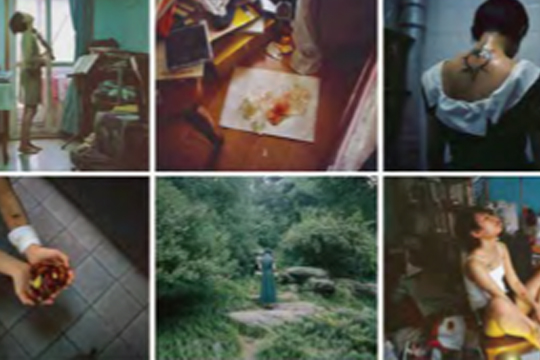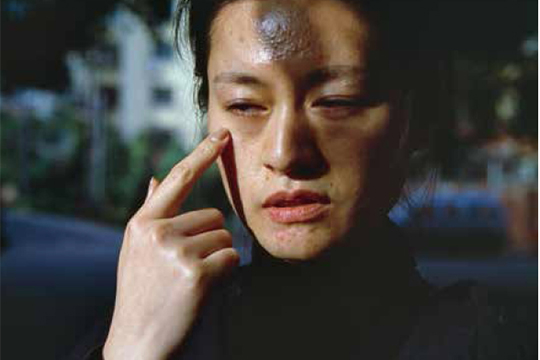CHEN ZHE: PUNCTURED BY A GAZE
| 2013年05月10日 | 发表于 LEAP 19

AT A VERY young age, Chen Zhe has already widely been touted as one of the most compelling Chinese photographers practicing today. In 2011 alone, she was the recipient of the Inga Morath Award, the Three Shadows Photography Award, and the Lianzhou Photographer of the Year award. These accolades are due, not in small part, to aesthetically effortless images born of meticulously wrought psychological complexities. The primary feature of most of her work to this day is self harm— i.e. deliberate injury to oneself, typically as a manifestation of a psychological or psychiatric disorder— which is as alienating in reality as it may be, despite its graceful presentation, to those who encounter her photographs. Chen Zhe’s photography stands out as the conscious “visualization” not only of the actions of self-harm, but of the conditions that surround it. Assuming that the camera assigns new meaning to self-injury by allowing the act to transcend the physical memory of pain is, to a degree, not entirely baseless. Without the intervention of the camera lens, perhaps the injury will cease to exist once the pain has gone and the scars disappeared— hence the need to repeatedly self-harm. Yet it might also be assumed that the excitement or pleasure of mutilating oneself is to a degree based in the thrill of seeing one’s own blood, in the fascination of watching a bruise form on one’s own body. Chen compounds the act of self injury by recording it, augmenting its psychological dimensions for both spectator and self-harmer by offering it to the public sphere.
In her breakthrough series “The Bearable,” the documentation of a half-decade of her own self-harming, the effect on Chen Zhe’s psychology was less immediate than gradual. In the beginning, her frames were but random, the first thing at hand worth shooting. Slowly, the photos took form of what the artist would later call “healing”; it was only through photographing her illness that she could succeed in overcoming it. The photographic act distilled pain and suffering to the point that the personal ceased to be at their whim. In other words, Chen’s art became a personal coping mechanism. This is far from novelty; innumerable creators of times past and present have confronted their own physical and spiritual struggles by way of the paintbrush, and even common folk turn to art as therapy in times of crisis or depression. But what of when the artist aims her lens away from herself?
Chen Zhe’s “Bees” documents the self-injury of a “marginalized group of people in China, who, faced with chaos, violence, alienation, and irredeemable losses in life, feel propelled to leave physical traces and markings on their bodies, in order to testify and preserve a pure and sensitive mind from within.” Just as within this universe the body is an isolated entity— we are born alone, we die alone, the existentialists, et al.— so are these “bees” cut off from society. (The term is in reference to the bees of Virgil’s The Georgics: “…if hurt, they breathe/Venom into their bite, cleave to the veins/And let the sting lie buried, and leave their lives/Behind them in the wound.”) For this series, Chen’s own identity as a self-harmer acted as both a means and an end— in order to gain her subjects’ trust and confidence, she would first have to prove “concatenated identities,” by revealing her own scars. Without anthropologically separating them from their own lives, from their wounds, Chen rejoins them with society through 90 photographs and 40 groups of letters and correspondence.

The viewer of these may sense empathy between artist and subject, but such feelings often meet barriers. Next to one young girl—who in one frame gazes through a cloud of smoke at her documenter, and in another stands in dark silhouette on a windowsill perched and ready to jump— hangs the handwritten assertion of another: “The way I see it, there are only two types of people in this world: those with no friends, and those with very few friends. Those who claim to have many friends are liars. And you, you are not my friend. You are just like me: another person with no friends.” Another carefully pens the following words on gridded school paper: “I do not have a self. It hasn’t been lost; I’ve simply never had one. I’ve always relied on imitation to survive.” And later in the same letter: “I am afraid. I do not wish to reveal myself to others, not even for a second. All I can do is take my life and flee to a corner somewhere, to a nice place that the sun has already abandoned. And there, I will swallow my last breath.”
Chen Zhe’s artistic interaction with human suffering can be equated to the philosophical introspection of the human body. With the camera, Chen parses out her subjects’ existence in the same way the thinker parses out his own body via logic and reasoning. She does for them what she does for herself: objectify the pain and depersonalize the trauma. Once her subjects are offered a logical distance from which to view themselves— perspectives that rejuvenate in direct proportion to time, offering subject unto itself, renewed as detached object— they are immediately more capable of understanding the reasons for their actions. The isolated “I” of the image helps relocate the isolated “I” of reality, to trigger a self-reflection no longer enshrouded by physical pain or existential isolation. (Chen’s relationship with them is therapeutic, but then again, aren’t all friendships?)
For her viewers, the effect is quite the opposite. The “Bees” are objectified from themselves and subjectified for us, so that we may internalize the trauma. The exhibited images generate communal cognizance, reminding us of the unseen and unspoken, and induce a visceral awareness of our shared physicality. This awareness is generated by, to invoke Barthes, punctum: “Personal memory based not on the public archive but a private repertoire… occurs when there is a match between a signifier in the scene (in the photograph), and a scene in the memory.” When we see the wounds on these people’s bodies, we helplessly recall the wounds we ourselves have sustained in life: when we first fell down and scraped our knees, when the nurse first took our blood, when we got our first tattoo… (More precisely: we come into contact with the inexplicable “essence” of these memories.) The most intensely private meaning pertains to our physiology and all its capacities, to the mortality we have both tasted and feared— “the impossible science of the unique being.” It is a precise indicator of our humanity that we cannot help but experience stomach-level discomfort amid the gaze of Chen Zhe’s art.
We should not forget that Chen Zhe is not a metaphysician, but an artist. Within the framework of contemporary art, one immediate (and rather conservative) reaction to Chen Zhe’s work is to seek parallels with the Viennese Actionists. Understandably: as with, say, Rudolf Schwarzkogler, much of her work involves the abuse of the body, often for the viewer in gruesome ways. Yet in Chen’s case, this abuse precedes the artwork, not the other way around. In its formalization, Chen’s practice softly yet emphatically eschews shock and controversy. She does employ the body as a surface for art’s creation—or rather, departs from it— but she does not exploit it. What some see as grotesque, she sees as beautiful. Hers is not political defiance, but personal alliance. It is a lucid exploration of suffering, of isolation, of the kindred thoughts, expressions, and actions that most of us dare not share.

